
A Bold Choice
This article first appeared in Duke Magazine. All photography by Alex Boerner.
When a Duke-led research team won a $300 million federal grant to help develop an AIDS vaccine in 2005, the global situation was looking grim.
Even as the epidemic largely disappeared from American newspapers, the number of people living with HIV, the AIDS virus, had climbed above 40 million for the first time. Sub-Saharan Africa was hit hardest: In Swaziland, a pregnant woman visiting a prenatal clinic had a four-in-ten chance of testing positive. But the disease was hammering vulnerable populations worldwide: unemployed Russians shooting heroin with dirty needles; Thai teens having unprotected hookups; Indonesian sex workers who feared getting arrested if police caught them with condoms. In the United States it was hitting young black gay and bisexual men, many of whom didn’t know they were infected.
Anti-viral medications kept many healthy. But the drugs were not universally available. And some officials were working at cross-purposes to the public health. South Africa’s health minister was urging patients not to take the medicines, which she called toxic, but instead to eat a diet of beets, sweet potatoes, and lemon skin. Uganda had curtailed the distribution of free condoms. And the U.S. government was pouring money into overseas abstinence programs that had little or no effect.
In 2005 alone, the United Nations and World Health Organization tallied 3 million AIDS deaths, including 570,000 children under fifteen. The two bodies jointly called for “great urgency” in wrangling the epidemic. “A vaccine to overcome HIV,” they declared, “is our most compelling hope.”
***
That summer, the National Institute of Allergy and Infectious Diseases (NIAID) cranked up its efforts to develop a vaccine. The agency, part of the National Institutes of Health (NIH), announced the winner of that seven-year, $300 million competitive grant: a single consortium of vaccine researchers from what would eventually become forty-three institutions. They would work together under a virtual umbrella called the Center for HIV/AIDS Vaccine Immunology. Heading the center would be physician Barton Haynes, director of the Duke Human Vaccine Institute (DHVI) at the Duke University School of Medicine.
The colossal award was a departure from the traditional system of giving smaller grants to individual investigators.
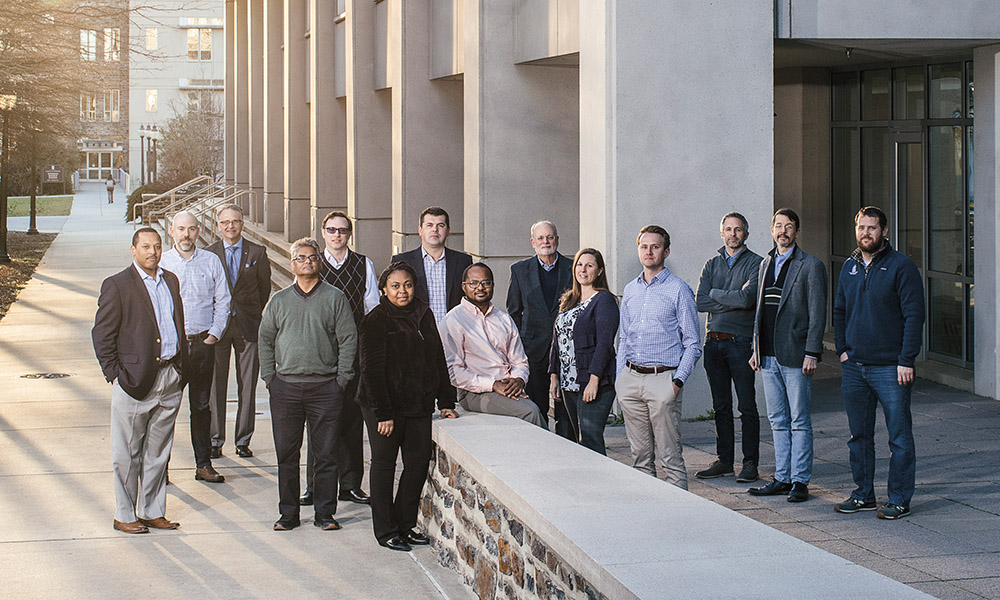
“It’s big science in the way that the Human Genome Project was,” Peggy Johnston, NIAID’s top AIDS-vaccine official, said at the time. Haynes and some of his colleagues had argued that the old system wasn’t working: HIV is such a vexing virus, defying all the usual methods of vaccine development, that a breakthrough required a whole new approach and a focused, big-dollar effort. It needed a critical mass of scientists from different disciplines, striving together toward a unified goal. They, in turn, needed expensive infrastructure and enough flexibility to shift money around as their needs changed. They also needed the ability to share their data seamlessly,without the usual turf wars that hinder scientific cooperation.
This was not a consensus view. Even before the Duke-led consortium won the grant, others were disparaging the big-science approach. “When you don’t know how to solve a problem, putting all the resources in the hands of a very small number of people—even very capable people—is not the way to do it,” Michael Lederman, a professor of medicine at Case Western Reserve University, told the journal Nature Medicine.
That was fifteen years ago. Since then, Haynes’ team has won two more large NIAID grants: a total of $639 million distributed over twenty-one years ending in 2026. They have also received funding from the Bill and Melinda Gates Foundation. That and other money has allowed them to build a turnkey operation, capable of not just doing basic research but also manufacturing vaccine components and conducting clinical trials.
Haynes has also built something that’s harder to visualize but equally essential: a worldwide, multidisciplinary collaboration of scientists who cooperate as if they all belong to the same lab.
“That structure is critical if what we want to achieves the ability to take what we learn in a laboratory, and what we learn from testing clinical samples, and turn that into an idea that can be tested as a vaccine,” says John Mascola, director of NIAID’s Vaccine Research Center. “It is very difficult to build that capability from start to finish. So Duke is a fairly unique example of an academic center, especially in vaccinology, that is able to do this.”
The international group has spent almost fifteen years probing HIV to give up its secrets. They have learned what makes it such a hardy organism, impervious to the virus-fighting proteins called antibodies. And they’ve developed new strategies to outwit the virus. They now believe, as do others outside the consortium, that a vaccine could be within the imaginable future. It won’t eradicate HIV altogether, they say. But it could significantly slow transmission.
“I still think it’s going to be a formidable challenge,” says Anthony Fauci, one of the world’s leading AIDS researchers and director of NIAID. “But I think, within a reasonable period of time, we’ll get an HIV vaccine that is 50, 60 percent effective, enough to have a major impact on the kinetics of the epidemic.”
Fauci, who mentored Haynes before the epidemic began, predicts the Duke physician and his consortium will ultimately deserve credit. “You’re dealing with a superstar who is leading a very impressive group of people,” he says. “If we’re going to get a vaccine for HIV, it almost certainly is going to be all or in part by this group.”
***
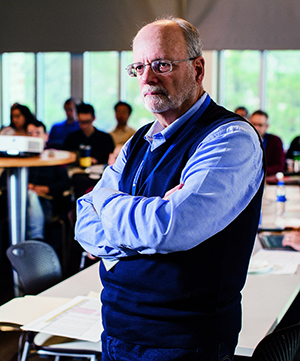
Barton Haynes is a bearded, jeans-wearing seventy-two-year-old who is famous among peers for his tirelessness. “He doesn’t need any sleep,” says Kelly Soderberg, DHVI’s chief of staff. “He will be here seven days a week, and it’s not because he’s afraid something will fall between the cracks. He is genuinely invested in solving the problem.”
Raised in a small Tennessee town, Haynes describes his early life as a series of fortunate handoffs from one mentor to the next. He graduated from medical school in 1973, interned at Duke, and then started his research career at the NIH. He soon landed in Fauci’s lab doing basic immunology research.
“He was showing signs at the earliest stage—the first two, three years of his career—of being someone who clearly was going to be a star,” Fauci says. “He’s intellectually brilliant. He’s very analytical. He’s extremely careful in his planning and his interpretation of the data.”
Haynes returned to Duke in 1980, this time as an associate professor. (He is now the Frederic M. Hanes Professor of Medicine.) It was an important era for those studying the immune system. The following year, the government reported that previously healthy gay men were coming down with two rare and aggressive diseases: Pneumocystis carinii pneumonia and a cancer called Kaposi’s sarcoma.
Haynes’ professional interests made him a logical candidate to study this cluster of illnesses, which would eventually be identified as AIDS. In 1982, he received a call from Robert Gallo, a scientist at the NIH’s National Cancer Institute. “This is going to be the greatest pandemic in the history of humanity,” Haynes remembers Gallo saying. (Gallo, who went on to establish HIV as the cause of AIDS, recalls the conversation.)
Haynes agreed to help out. He and Dani Bolognesi, now a professor emeritus of surgery at Duke, joined a task force that Gallo convened. At home, Haynes joined with the University of North Carolina’s Hemophilia Center to study AIDS patients who had gotten infected after being treated with a clotting protein made from human blood. Once HIV emerged as the culprit behind AIDS, Haynes and Bolognesi began working on a vaccine.
“We all thought in 1984, after the virus was confirmed, that it was going to be just like Hepatitis B and other vaccines,” Haynes says—that is, a relatively straightforward endeavor. They would take the part of the HIV virus that protective antibodies target, manufacture a test-tube version of it, and inject it first into non-human primates and then into people. This would trigger the body to produce its own antibodies, ready to fight the real virus if it came along. “And we’d be done in two years,” he says.
Over two decades, the field tried numerous approaches. “None of the strategies worked,” Haynes says. “A lot of dead ends.”
HIV, it turns out, has developed myriad ways to fool our bodies. For one, it mutates like crazy, and our antibodies can’t keep pace.
“It’s one of the universe’s best escape artists,” says Kevin Wiehe, an assistant professor in medicine and DHVI’s associate director of research. The immune system evolves quickly, too, in an attempt to overcome the virus. But “HIV seems to always be one step ahead,” Wiehe says. “It always wins.”
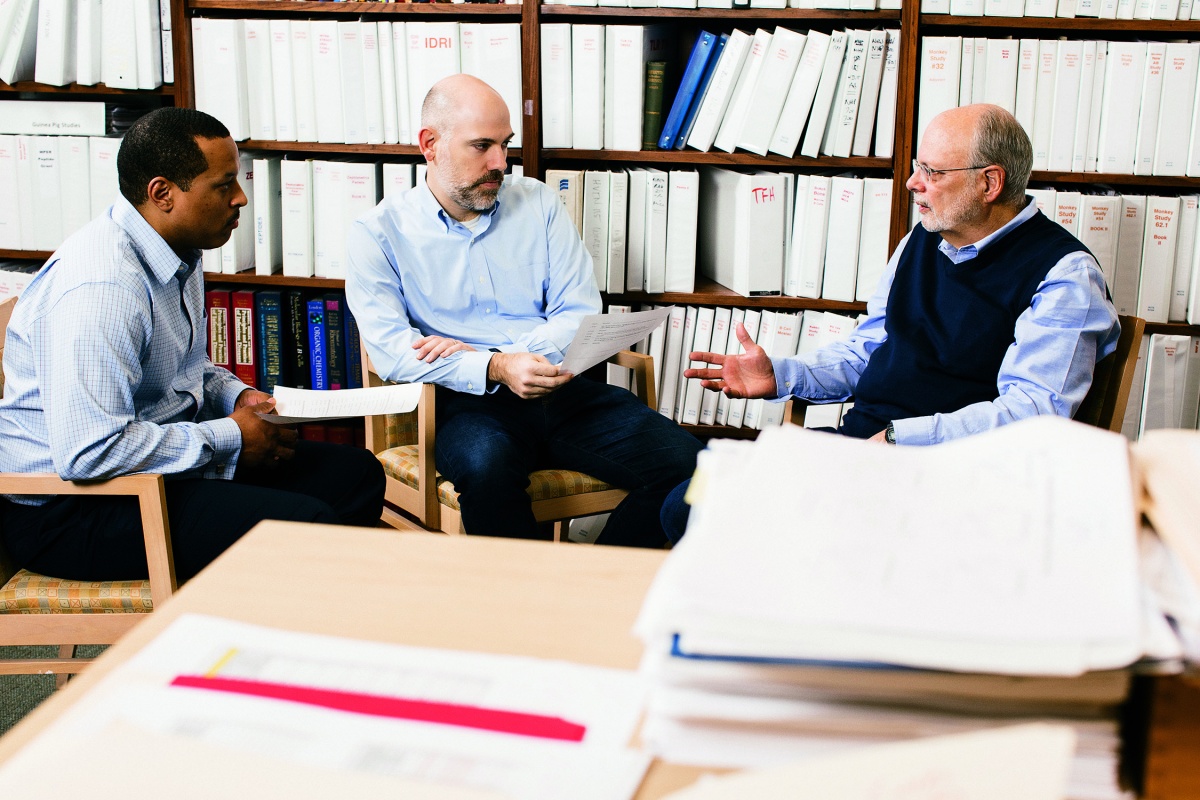
What’s more, as Haynes discovered, HIV has evolved to mimic its host—to appear “more human,” says Wiehe. “The immune system is set up not to attack itself, so it’s a very clever way for the virus to evade the immune system.”
Another evolutionary masterstroke: HIV infects the very cells that are designed to kill it.
“As your immune system is making more cells to fight against it, it actually is creating more targets for infection,” says Kevin Saunders Ph.D. ’10, an assistant professor in surgery and DHVI’s director of research. The infected immune cells then die off, making it harder for the body to fight the virus long term. The die-off also impairs the body more generally, which is why people with AIDS sometimes develop fatal diseases like Pneumocystis, which don’t harm uninfected people.
Little surprise, then, that the early years proved disappointing. Haynes might have moved onto other professional pursuits if not for an overseas trip that reinforced his priorities.
***
By 2001, Haynes was chairing Duke's department of medicine and wondering if he should shift his career toward administration. He was also running DHVI, which he and Bolognesi had co-founded and which at the time had just a few employees.
Some of Haynes’ HIV-research colleagues were working in Zambia, a land-locked country in southern Africa where one-fifth of the adult population was infected. Haynes wanted to set up collaborations there, so he joined a University of Alabama epidemiologist on a visit. It was his first time in a developing country, and it drove home the human toll of the epidemic.
Haynes visited an orphanage that housed some of the world’s second largest population of AIDS orphans. He talked to community leaders who were trying to build schools for those children. At University Teaching Hospital, he tailed physicians as they made rounds.
“We were seeing bed after bed of AIDS patients for whom the only treatment was pain control,” he recalls. “And then going to the pharmacy—I have pictures of the empty pharmacy cabinets.”
He listened as doctors described the hope they placed in vaccine research. And he kept a journal.
“This trip will turn out to have been the most important six days of my professional life,” he wrote. “It has helped find the perspective I needed—helped me find my way during the last half of my professional life."
Haynes would not become an administrator after all. “I decided to go back to science,” he says, “and to work on this problem full time.”
By then, it was clear that a vaccine was unlikely to come from the private sector.
“The pharmaceutical companies had dropped out of it,” says Haynes’ longtime colleague Larry Corey, principal investigator at the HIV Vaccine Trials Network at the Fred Hutchinson Cancer Research Center in Seattle. “Academia was the structure that needed to move into it.”
Making inroads, Haynes believed, meant convincing the powers-that-be to fund a big-science effort. In 2003, he joined two dozen prominent AIDS researchers in penning a plea in the journal Science for the creation of large, coordinated centers that would produce a “systematic and coordinated pipeline” of vaccine candidates. “Tens of millions of lives are dependent on the development of a safe and effective HIV vaccine,” they wrote. The Science article set in motion a process that led to the large grant that NIAID awarded in 2005.
Four consortia, including the Duke-led one, competed for the $300 million. Others grumbled about the grant. Nature Medicine sent a reporter to a biomedical conference in Banff, Canada, where she found that “researchers could talk about little else in between seminars, over drinks or at poster sessions.”
Some argued that the world’s leading HIV scientists should be sharing the funds and focusing on different goals, rather than competing for an all-or-nothing award.
“Why shoot yourself in the foot by disqualifying 75 percent of the best researchers?" said Neal Nathanson, then associate dean of global health programs at the University of Pennsylvania. Nathanson has since retired and declined to comment for this story. Three other past critics, including Lederman, didn’t respond to interview requests.
DHVI’s scientists insist that scale matters: It frees researchers from scrambling to pay for equipment or personnel.
“When you don’t have to worry about those logistics, but you worry about the science, that’s when you can make progress,” says Saunders. “The large grants have propelled the field forward at the speed of the intellectual process. It’s not the speed at which you’re waiting for a piece of equipment, or the speed at which you’re waiting for enough money to do the in vivo studies.”
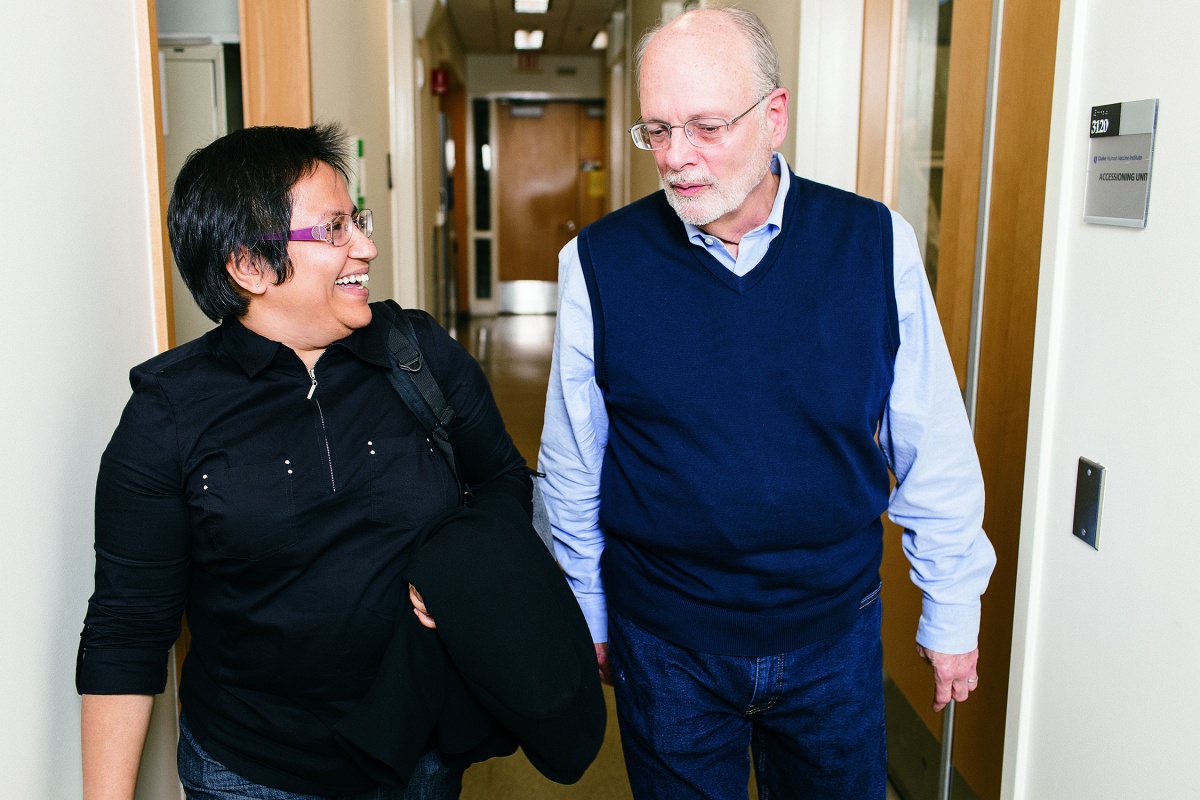
What’s more, a large consortium means collaboration across disciplines.
“The sheer amount of expertise that’s required cannot be really held in one person’s brain,” says Wiehe. “No one person, or even one lab, could figure all of this out. I can’t even imagine how you could do it without some sort of big-science approach.”
***
Each of the seven-year grants has funded a different phase of the research: figuring out what makes HIV so hard to conquer; developing strategies to overcome those obstacles; and now, in the final phase, turning those strategies into vaccines and testing them in humans.
Some of the consortium’s work began in Africa, where the epidemic remains most intense. Led by Myron Cohen, a physician at the University of North Carolina, researchers set up eight research sites at clinics in five countries. They screened 16,486 people, hoping to find some who had just gotten infected and not yet produced antibodies. They identified 312 newly infected individuals, each representing an opportunity to see how the body initially responds to HIV.
The blood serum of those 312, plus a similar number who had been infected for longer, produced a wealth of information. Researchers at the University of Alabama and Los Alamos National Lab made what Haynes calls an “astonishing” discovery: Even though an individual with HIV might have billions of variants of the virus in their body, when they infect a partner, it’s generally with a single virus particle.
"That was the first bit of good news," Haynes said. "We don't have to protect against a variant that's out there, but rather the smaller set that infect others."
One major goal of the Africa study was to identify those rare individuals whose bodies naturally made potent antibodies against HIV. Scientists call them “broadly neutralizing antibodies,” because they can stop many different strains of HIV from invading human cells. To find those individuals, David Montefiori, a professor of surgery at Duke, screened the serum of hundreds of African research subjects and classified them by the types of antibodies they produced.
Scientists then studied the genetic changes that took place in those who made the powerful antibodies, and those who didn’t. “We performed a large series of studies and asked, ‘What’s going on when the good things happen, and what’s going on when they don’t happen?’” Haynes says.
From there, the science unfolded in layers. When people do produce broadly neutralizing antibodies, it doesn’t happen immediately. Rather, it’s the product of a series of mutations: a years-long contest of genetic oneupmanship between the immune system and HIV. Haynes calls this “co-evolution” because the virus and antibodies evolve together, each reacting to the other’s changes.
One of the African individuals, who was first tested a month after infection, eventually developed broadly neutralizing antibodies. (For privacy, their nationality and gender are kept confidential.)
By tracking that person for more than three years, researchers from Duke, the National Institutes of Health, and elsewhere were able to map the series of genetic changes that both the virus and the antibodies underwent. They published their findings in Nature in 2013.
“Bart pioneered the study of virus antibody co-evolution,” says NIAID’s Mascola. Once Haynes and his team saw how HIV and antibodies took advantage of each other’s vulnerabilities, Mascola says,“he began to use the information from natural infection to design a vaccine that would teach the immune system to make potent antibodies to HIV.”
That, ultimately, led to a groundbreaking paper, published last December in Science: Researchers from Duke, Harvard University, and elsewhere had coaxed the immune systems of mice and monkeys to produce broadly neutralizing antibodies. This is not the same as creating a fully working vaccine. But it overcomes a “major roadblock” by eliciting genetic changes in the antibodies that the body doesn’t want to make naturally, says Saunders,who (along with Wiehe) is one of four co-first authors on the paper.
To do this, the scientists relied, in part, on the genetic map from that same newly infected individual in Africa.
***
Managing a research program of this scale was a new experience for Duke. There was so much to figure out: how to hit the spending targets with precision, how to comply with all the rules, how to make sure big-science coordination didn’t interfere with the serendipity and individual initiative that often drive discovery.
"We had to learn as we were flying," says Tom Denny, a professor in medicine and DHVI’s chief operating officer. His colleagues circulated a funny video of a commercial airplane soaring through the sky, filled with passengers, as workers bolted its body together.
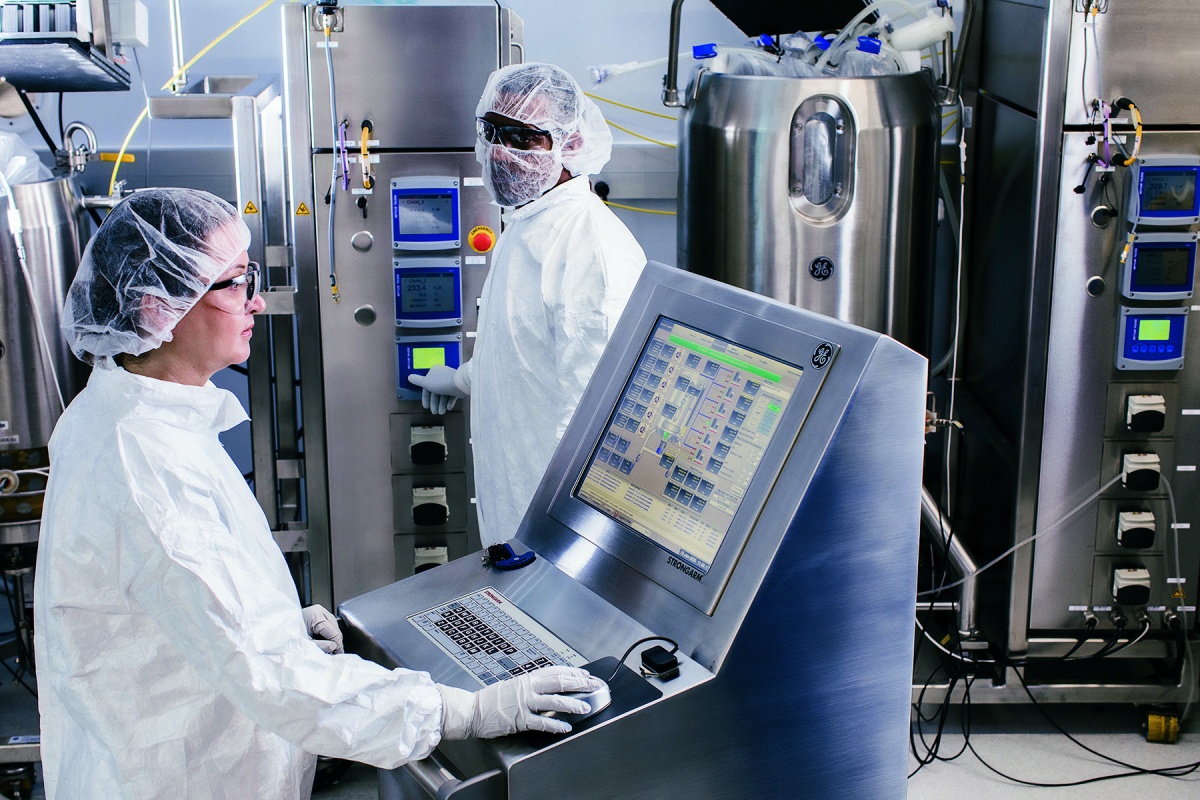
Everyone was hyper-aware of the number of dollars at stake and the controversy surrounding the grant. “We had an incredible amount of visibility and accountability on us,” says Denny. “You had the NIH that gave money and wanted success. You had Duke that said, ‘Don’t mess it up.’ And then you had the science community saying, ‘You guys shouldn’t have this.’ So whichever direction you turned, there was pressure to make sure you got everything right.”
Some of the lessons came hard. Initially, DHVI contracted with private industry to manufacture the ingredients for clinical trials.
“It was a disaster,” says Wiehe. “You think you’re going to get their A team working on your product. But you get the B team or the C team.”
In one case, Denny recalls, DHVI hired a private company to make components for four vaccines. Six months later, the company came back and raised the price from $12 million to $25 million.
“What do you do when you’re building a house, and you’ve got half the house built, and you builder says to you, ‘Well, if you want to put a roof on it, the price is going to double?’ ” Denny says. “You’re too deep in the hole at that point.”
Something needed to change. DHVI needed its own in-house manufacturing capacity.
Denny and Haynes secured $5 million from the medical school’s then-dean, Nancy Andrews, to build a sterile facility where vaccine components could be produced. “We had a lot of people saying,‘You don’t know what you’re doing. You’ve never made product before. You’re academic scientists,’” Denny recalls. So he hired an outside auditor to review planning and construction, and then hired a specialized search firm to find experienced professionals to staff the facility.
According to Denny, the sterile facility has successfully made three products, possibly cheaper but certainly faster than private industry could have. It quickly proved too small. With federal and university funding, DHVI is now retrofitting its building to add four more manufacturing suites: restricted-access rooms with modular walls, ports in the ceilings, and stainless-steel machines costing, in some cases, hundreds of thousands of dollars.
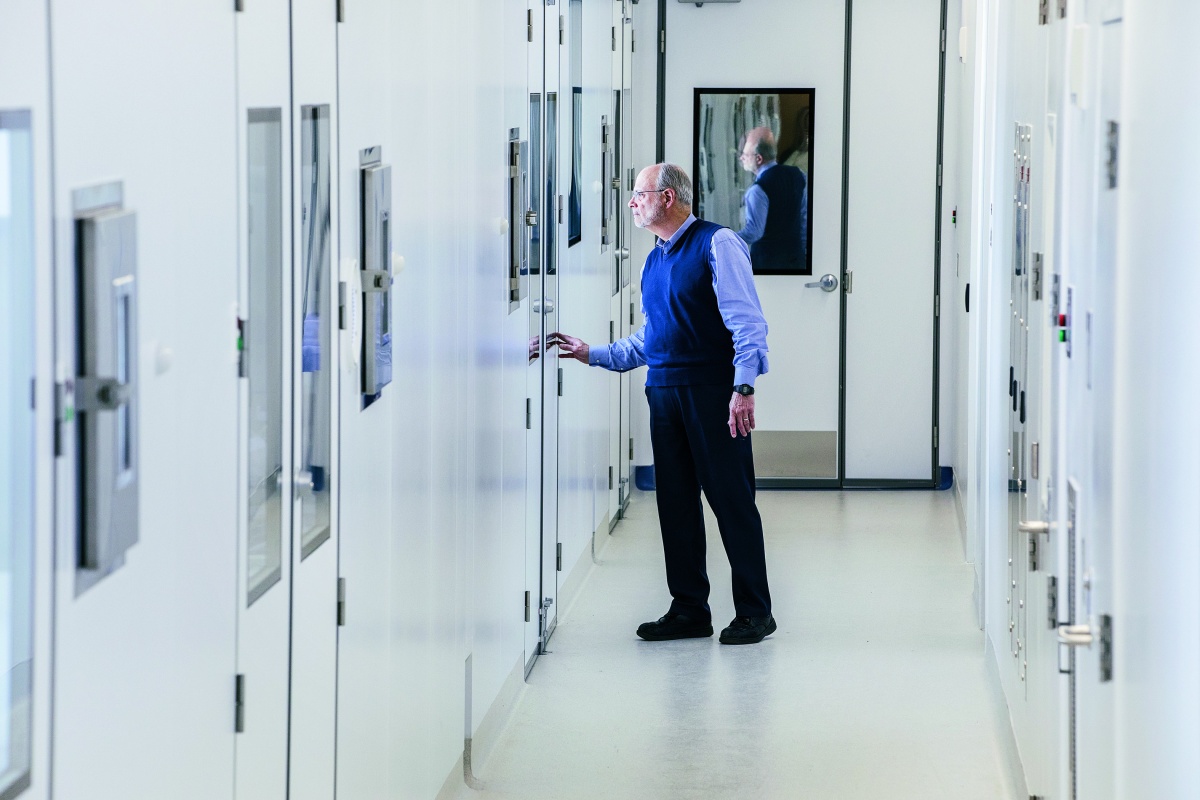
Meanwhile, Haynes had to build a different type of infrastructure: a network of researchers willing to set aside the competitiveness that often defines their cultures. “All of us were used to not talking about our research until it was published,” he says. “It took a bit to make the transition.” The scientists had to learn to share information across the organization without worrying their ideas would be stolen.
Haynes had all the investigators sign confidentiality agreements. From the beginning, he modeled the culture he wanted by talking freely about his own lab’s day-to-day accomplishments. It took a year, he says, until his colleagues felt comfortable doing the same.
To this day, Haynes reinforces this spirit of collaboration at every large consortium meeting.
“Welcome,” he says. “This is a big lab meeting. If you hear anything that’s of interest, go to the person from whom you found it and collaborate. You cannot take it and run with it.”
This is high-touch science. Data don’t just get handed off in written form; people sit down together and talk. Matt Johnson, a former drug-company researcher, now leads the manufacturing effort as DHVI’s senior director of product development.
Every Wednesday morning, he and some of his managers attend laboratory meetings with Haynes and Saunders and look at their results. “If you were to go to a lot of pharmaceutical industry partners or other research environments, you would not see that connection of teams physically sitting together and looking at data," he says." "We can provide them real-time feedback, and they can also ask us questions: 'Hey is this a feasible approach? Do you see any concerns as we take this toward a human trial? That cross-pollination is incredibly strong."
***
If there's any chance of forgetting what's at stake in the quest for an HIV vaccine, that memory is reignited when you enter the Duke Human Vaccine Institute’s headquarters. Hanging inside the atrium is a colorful panel from the AIDS Memorial Quilt, with individual rectangles recalling people who died in the 1990s. They include ten Duke pediatrics patients, one just three months old.
“There has never been an epidemic that has sustained the death rate that HIV has had, not in history,” says Larry Corey of the HIV Trials Network. "Our generation of scientists is going to be defined by how we handle the epidemic.”
For Haynes, the imperative is amplified by a personal sense of his own good fortune. His life could have turned out differently: He grew up in the rural South during the Vietnam War and recalls his draft number was low.
Haynes’ Selective Service classification was 1-A, he says, which means he was eligible to be drafted and sent into battle. He thinks about that still. And he thinks about that chain of mentors who guided him from high school to the start of his career, even when he floundered.
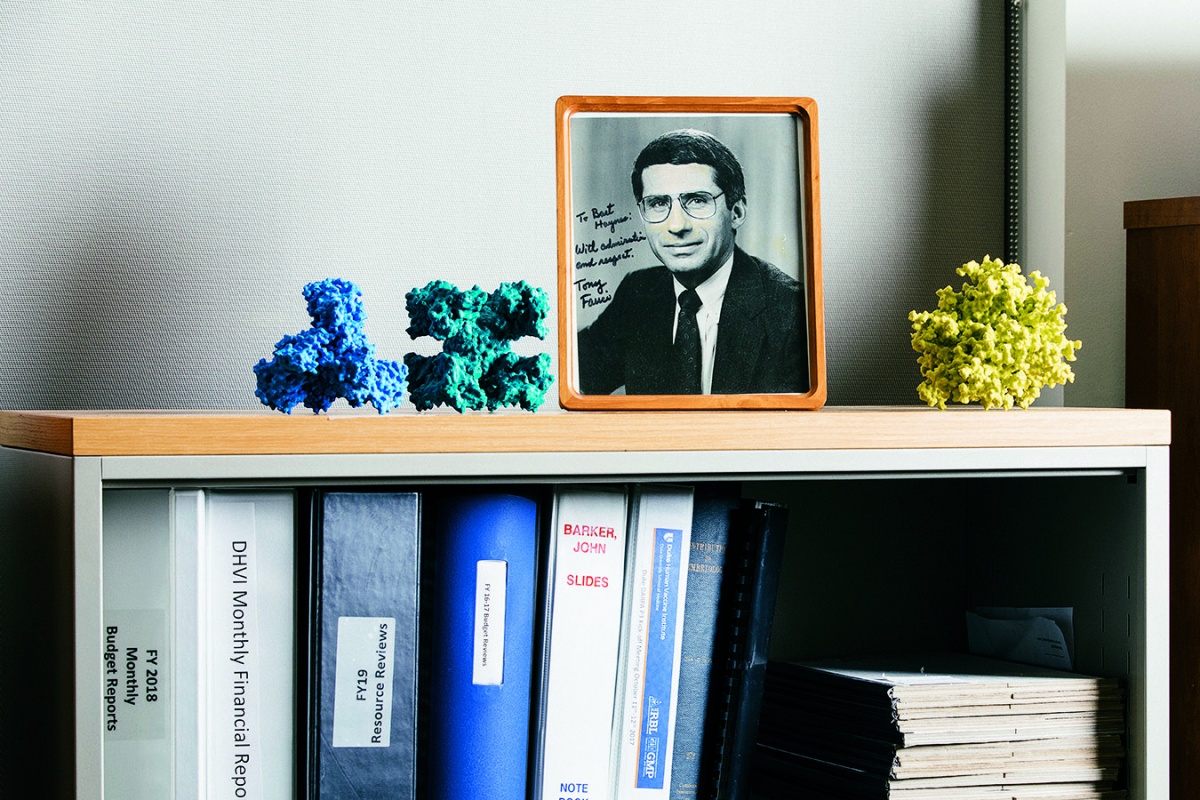
“But for grace of any one of those individuals, I could have easily never made it in my path,” he says. “And I know that. So I’m very, very grateful. I get up every day feeling how wonderful it is to have an opportunity to contribute.”
An HIV vaccine would crown Haynes’ career, but that’s not his intended end point. Haynes has been working to parlay his organization’s team-building and research skills, not to mention its state-of-the-art infrastructure, into large new grants.
Last fall, DHVI received $28 million from NIAID to house a quality-assurance program for laboratories that do HIV research. It also won three NIAID contracts that, if fully funded, will total $400 million over seven years. Those awards will fund yet another multi-institutional effort—this time to develop a universal flu vaccine.
Barry Yeoman teaches journalism and public policy at Duke's DeWitt Wallace Center for Media & Democracy.
Alex Boerner is a freelance photographer based in Durham, North Carolina.
